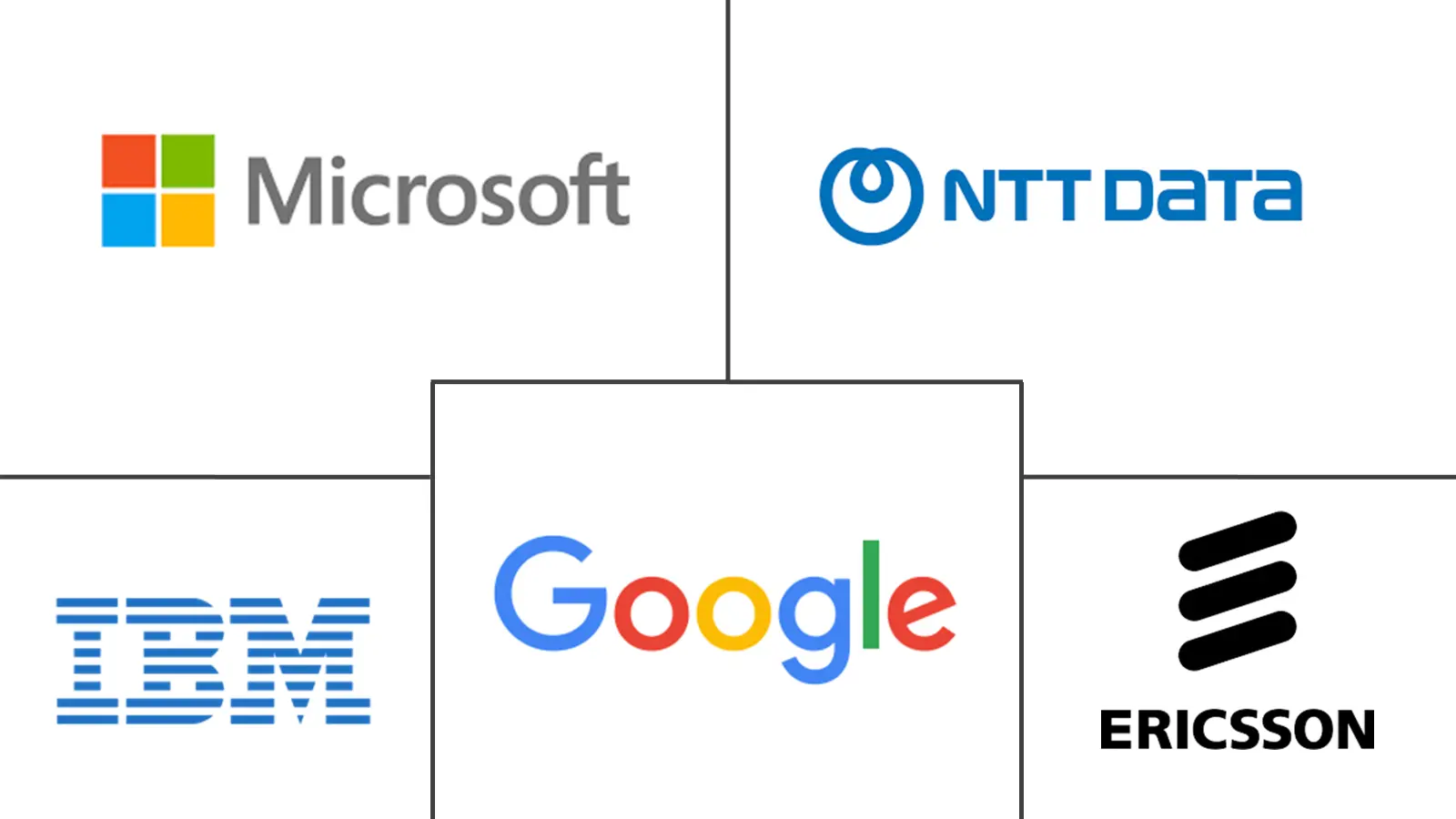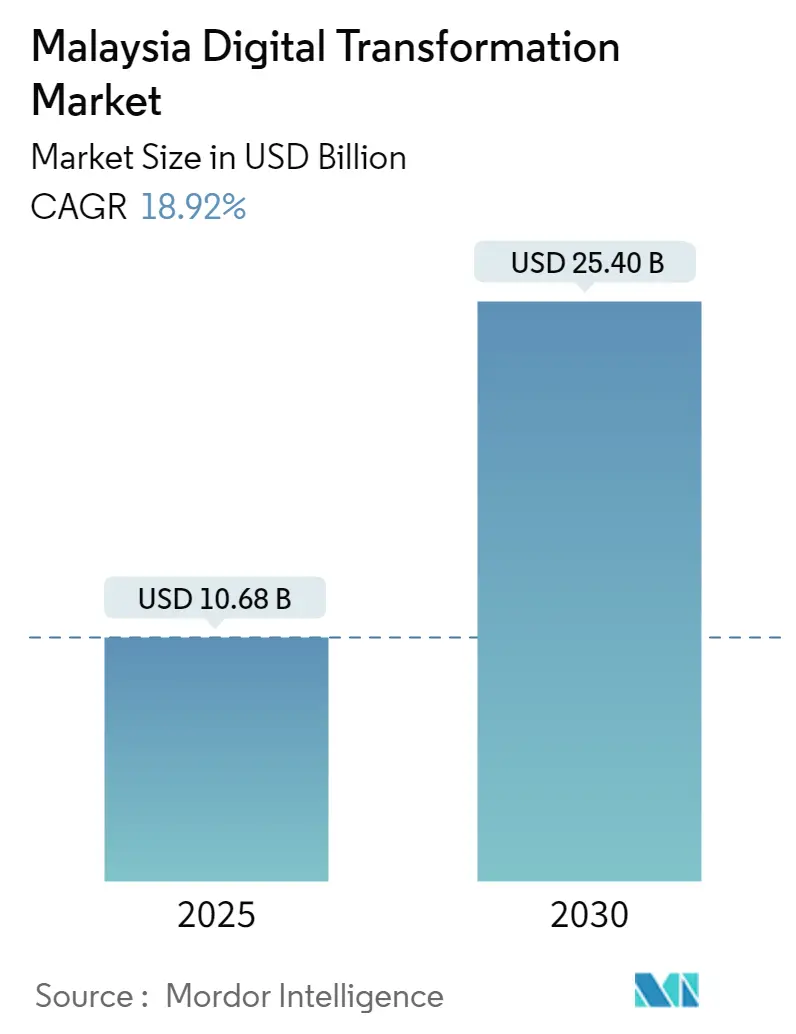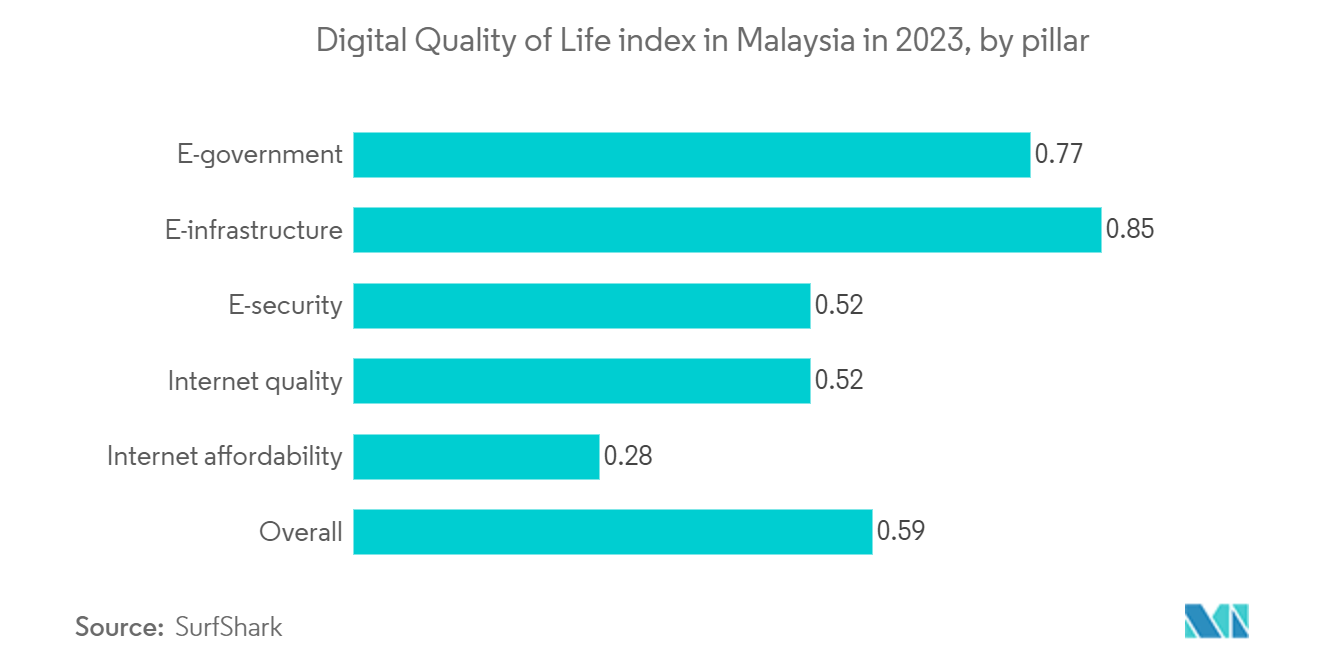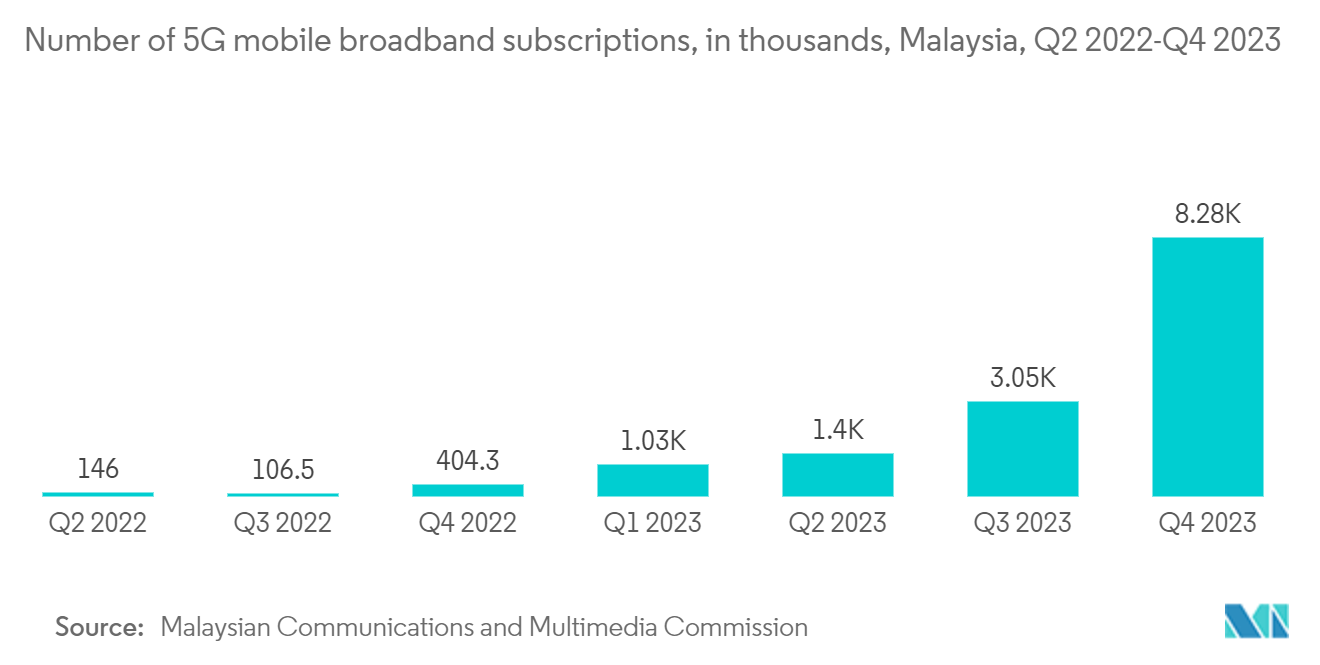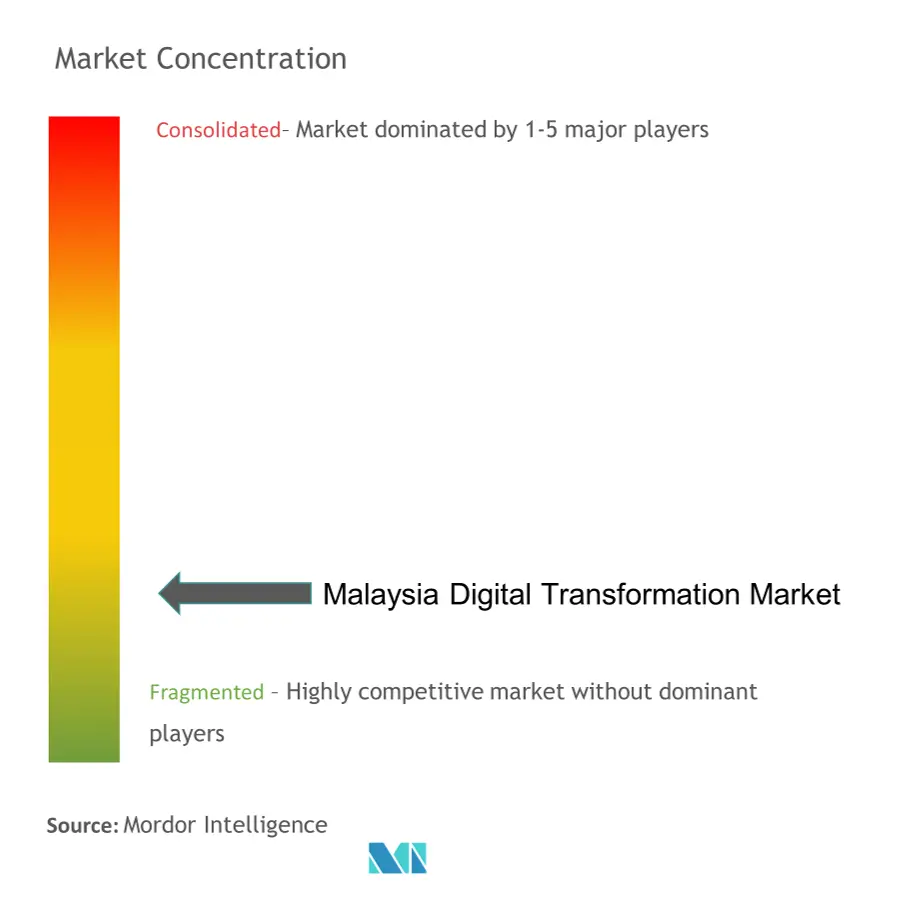Malaysia Digital Transformation Market Analysis
The Malaysia Digital Transformation Market size is estimated at USD 10.68 billion in 2025, and is expected to reach USD 25.40 billion by 2030, at a CAGR of 18.92% during the forecast period (2025-2030).
- Malaysia is actively adopting digital transformation, reshaping its economic landscape and enhancing its digital economy. Driven by a commitment to innovation, the nation is leveraging advanced technologies to advance its digitalization efforts.
- The Malaysian government is involved in strengthening Malaysia's Digital initiative, aiming to accelerate the growth of Malaysia's digital ecosystem across nine key sectors including digital agriculture, digital services, digital cities, digital health, digital finance, digital trade, digital content, digital tourism, and the Islamic digital economy. These sectors are recognized as growth drivers, holding immense potential to boost Malaysia's digital transformation.
- In 2022, the Malaysian government launched the Malaysia Digital Initiative, focusing on the development of nine key sectors in the country's digital economy. Established by the Ministry of Communications and Multimedia through the Malaysian Digital Economy Corporation (MDEC), the initiative aims to attract companies, talents, and investments. It also seeks to enable Malaysian businesses and citizens to play a leading role in the global digital revolution and economy.
- The Malaysian digital economy is rapidly transforming the business landscape, experiencing significant growth and investment across diverse industries. Startups are driving the digital economy by changing markets with innovative technology and new business models.
- However, Malaysia struggles with a persistent shortage of skilled professionals capable of leading digital transformations. This talent deficit poses a significant challenge for local organizations, hindering their capacity to harness digital tools effectively.
Malaysia Digital Transformation Market Trends
Cloud Edge Computing to Register Significant Growth
- With the rise of new applications and services in Malaysia, the need for architecture designed to support distributed infrastructure is increasing. Companies are leveraging cloud architectures for their distributed setups across various sites and networks due to their streamlined management and adaptability. For example, in the IoT sector, data flows from numerous microsites, highlighting the advantages of an edge computing approach.
- Malaysia's emphasis on digitalization, cloud computing, and AI, bolstered by robust network infrastructure and numerous port cities, primes the nation for cutting-edge technological progress and enhanced global integration. In September 2023, EdgeConneX expanded its business in the Malaysian market, to set up high-capacity data centers across three key locations. This strategic expansion is poised to yield a collective capacity of nearly 300 MW.
- Moreover, in September 2023, Telekom Malaysia Berhad (TM) and SK Telecom signed a Memorandum of Understanding (MoU) to collaborate on developing Malaysia's Multi-Access Edge Computing (MEC) landscape. This partnership is expected to bring opportunities and implementing MEC services in Malaysia.
- Moreover, the role of cloud computing in advancing digitalization and driving business growth has become increasingly crucial. Small and Medium Enterprises (SMEs) now depend on digital transformation to stay competitive and achieve expansion. In March 2024, SME Association of Malaysia (SME Malaysia) encouraged SMEs to advance up the value chain by digitalizing business processes and implementing factory automation. This initiative supports the government's economic goal of achieving high-income nation status by 2025.
The IT and Telecom Sector is Expected to Drive the Market
- Malaysia is intensifying efforts to expand its 5G infrastructure, recognizing the pivotal role it plays in bolstering economic growth, attracting investments, fostering innovation, and amplifying productivity gains. This strategic move not only propels Malaysia's economic development but also fortifies its global competitiveness.
- According to Malaysian Communications and Multimedia Commission, in Q4 2023, Malaysia had around 8.2 million 5G-enabled mobile broadband subscriptions, marking a surge from the three million subscriptions in the preceding quarter. Over the past year, Malaysia witnessed a substantial rise in its 5G mobile broadband subscriptions.
- Further, according to GSMA Intelligence, Malaysia had 44.5 million cellular mobile connections at the start of 2024, representing 129.2% of the country's population. During the period from 2023 to 2024, Malaysia saw an increase of 169 thousand mobile connections, marking a growth of 0.4%.
- In October 2023, NTT, a Japanese IT services provider, has opened its sixth data center, CBJ6, in Malaysia's Cyberjaya science park and tech hub. This project, representing a significant US$50 million (S$68 million) investment. Covering 4,890 square meters, CBJ6 features a substantial IT load capacity of 7MW and supports power densities of up to 15 kW, powered by two 33 kW substations. NTT also emphasized the strategic importance of the forthcoming MIST optical submarine cable, which will connect Malaysia, Singapore, and India. This cable aims to enhance connectivity between CBJ5 and CBJ6 and improve Malaysia's overall network infrastructure.
Malaysia Digital Transformation Industry Overview
The Malaysia Digital Transformation Market is fragmented, with numerous players currently operating. Key players in the ICT market are continuously striving for advancements. Several prominent companies are forming collaborations and expanding their presence in developing regions to strengthen their market positions. IBM Corporation, Microsoft Corporation, Google LLC among others are major players.
- May 2024: Digital Nasional Berhad (DNB) and Ericsson launched a collaborative initiative to drive the digitalization of enterprises in Malaysia. This initiative harnesses the advanced capabilities of the 5G network, renowned for its high-speed and low-latency performance. These 5G features enable efficient communication among factory machines, robots, and systems, thereby boosting productivity and efficiency.
- May 2024, Microsoft unveiled a substantial commitment of USD 2.2 billion, earmarked for Malaysia's digital evolution over the ensuing four years. The initiative includes establishing cloud and AI infrastructure locally, offering AI training to an additional 200,000 residents, enhancing its partnership with the Malaysian government to establish a national AI Center of Excellence and fortify the nation's cybersecurity.
Malaysia Digital Transformation Market Leaders
-
IBM Corporation
-
Microsoft Corporation
-
Google LLC
-
Telefonaktiebolaget LM Ericsson
-
NTT Data
- *Disclaimer: Major Players sorted in no particular order
Malaysia Digital Transformation Market News
- March 2024: Google collaborated with the Government of Malaysia, has launched two strategic initiatives to enhance Malaysia’s digital competitiveness. The first initiative focuses on equipping Malaysian youth with AI skills, while the second aims to improve public service delivery using cloud-native, AI-driven tools, in line with Malaysia’s MADANI Economy Framework. The second initiative will equip 445,000 public officers with Google Workspace tools to boost productivity across the public sector. This effort is in partnership with Jabatan Digital Negara (JDN), the government agency responsible for coordinating and implementing national and public sector digitalization projects under the Ministry of Digital.
- March 2024: BlackBerry Limited has inaugurated its Cybersecurity Center of Excellence (CCoE) in Kuala Lumpur. This new facility is dedicated to providing premier cybersecurity training and intelligence, aiming to enhance Malaysia and its regional partners' capabilities in addressing cyber threats prevalent in the Indo-Pacific region.
Malaysia Digital Transformation Industry Segmentation
Digital transformation leverages digital technologies such as artificial intelligence and machine learning, extended reality (XR) for industrial applications, IoT, among others to create new business processes or modify existing ones, reshape organizational culture, and enhance customer experiences.
Malaysia digital transformation market is segmented by type (analytics, artificial intelligence, and machine learning, extended reality (XR), Iot, industrial robotics, blockchain, additive manufacturing/3D printing, cybersecurity, cloud and edge computing, and others [digital twin, mobility, and connectivity]), end-user industry (manufacturing, oil, gas and utilities, retail & e-commerce, transportation and logistics, healthcare, BFSI, telecom and IT, government and public sector and others), the market sizes and forecasts are provided in terms of value in (USD) for all the above segments.
| By Type | Analytics, Artificial Intelligence and Machine Learning | Current Market Scenario and Market Projections for the Forecast Period | |
| Key Growth Influencers (Drivers, Challenges, and Opportunities) | |||
| Use Case Analysis | |||
| Market Outlook | |||
| Extended Reality (XR) | Current Market Scenario and Market Projections for the Forecast Period | ||
| Key Growth Influencers (Drivers, Challenges, and Opportunities) | |||
| Use Case Analysis | |||
| Market Outlook | |||
| IoT | Current Market Scenario and Market Projections for the Forecast Period | ||
| Key Growth Influencers (Drivers, Challenges, and Opportunities) | |||
| Use Case Analysis | |||
| Market Outlook | |||
| Industrial Robotics | Current Market Scenario and Market Projections for the Forecast Period | ||
| Key Growth Influencers (Drivers, Challenges, and Opportunities) | |||
| Use Case Analysis | |||
| Market Outlook | |||
| Blockchain | Current Market Scenario and Market Projections for the Forecast Period | ||
| Key Growth Influencers (Drivers, Challenges, and Opportunities) | |||
| Use Case Analysis | |||
| Market Outlook | |||
| Additive Manufacturing/3D Printing | Current Market Scenario and Market Projections for the Forecast Period | ||
| Key Growth Influencers (Drivers, Challenges, and Opportunities) | |||
| Use Case Analysis | |||
| Market Outlook | |||
| Cybersecurity | Current Market Scenario and Market Projections for the Forecast Period | ||
| Key Growth Influencers (Drivers, Challenges, and Opportunities) | |||
| Use Case Analysis | |||
| Market Outlook | |||
| Cloud Edge Computing | Current Market Scenario and Market Projections for the Forecast Period | ||
| Key Growth Influencers (Drivers, Challenges, and Opportunities) | |||
| Use Case Analysis | |||
| Market Outlook | |||
| Others (digital twin, mobility and connectivity) | Current Market Scenario and Market Projections for the Forecast Period | ||
| Key Growth Influencers (Drivers, Challenges, and Opportunities) | |||
| Market Breakdown by Type (Digital Twin, Mobility and Connectivity) | |||
| Use Case Analysis | |||
| Market Outlook | |||
| By End-User Industry | Manufacturing | ||
| Oil, Gas and Utilities | |||
| Retail & e-commerce | |||
| Transportation and Logistics | |||
| Healthcare | |||
| BFSI | |||
| Telecom and IT | |||
| Government and Public Sector | |||
| Others (Education, Media & Entertainment, Environment etc) | |||
Malaysia Digital Transformation Market Research FAQs
How big is the Malaysia Digital Transformation Market?
The Malaysia Digital Transformation Market size is expected to reach USD 10.68 billion in 2025 and grow at a CAGR of 18.92% to reach USD 25.40 billion by 2030.
What is the current Malaysia Digital Transformation Market size?
In 2025, the Malaysia Digital Transformation Market size is expected to reach USD 10.68 billion.
Who are the key players in Malaysia Digital Transformation Market?
IBM Corporation, Microsoft Corporation, Google LLC, Telefonaktiebolaget LM Ericsson and NTT Data are the major companies operating in the Malaysia Digital Transformation Market.
What years does this Malaysia Digital Transformation Market cover, and what was the market size in 2024?
In 2024, the Malaysia Digital Transformation Market size was estimated at USD 8.66 billion. The report covers the Malaysia Digital Transformation Market historical market size for years: 2019, 2020, 2021, 2022, 2023 and 2024. The report also forecasts the Malaysia Digital Transformation Market size for years: 2025, 2026, 2027, 2028, 2029 and 2030.
Malaysia Digital Transformation Industry Report
Statistics for the 2025 Malaysia Digital Transformation market share, size and revenue growth rate, created by Mordor Intelligence™ Industry Reports. Malaysia Digital Transformation analysis includes a market forecast outlook for 2025 to 2030 and historical overview. Get a sample of this industry analysis as a free report PDF download.

